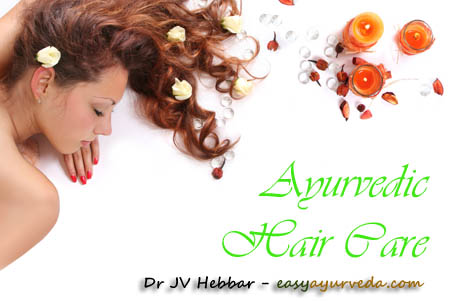Hair Dye Allergy: Effective Ayurvedic Treatment, Medicines
Article by Prof. MS Krishnamurthy MD (Ayu)., PhD.
In earlier days hair coloring was made from varieties of herbal and natural mineral substances.
In 1909 for the first time Eugene Schuller created the first safe commercial hair coloring and his innovation was based on a new chemical namely, Paraphenylenediamine.
He founded a company called the French Harmless Hair Dye Company. After a year the name of the company was changed and it is familiar now as L’Oreal. It has become a giant in hair care products now.

Before the invention of chemical hair dyes including the Indians, in other countries too they used to practice leaf of Henna (madayantika-(Lawsonia inermis)), seed of Mango, Fruit rind of Terminalia belirica (Vibheetaki in Sanskrit),Terminalia chebula(known as Hareetaki in Sanskrit), Indigifera tinctoria (Neelini in Sanskrit), turmeric (Haridra in Sanskrit),Gooseberries etc.
Other than these they used to make various combination including the substances of mineral origin like Kaseesa (natural form of Ferrous sulphate) ,Gairika (Red ochre),Neelanjan (Stybnite) etc alone or in combination with herbal ingredients.
Often they were taking the help of wall nut seeds, seeds of marking nut (Semicarpus anacardium) etc too make into the natural dyes.
The teas such as black or hibiscus that are made from black tea leaves and hibiscus flowers were also natural ways to color the hair and still being practiced in many parts of the country.
Till the time the incidences of allergy towards such natural coloring agents was less.But later on as the synthetic molecules came to practice the utility of dying agents was also increased and in turn the incidences of hair dye allergy was also took up word ranking among the cosmetic allergies.
Most commonly added chemicals in hair dye compounds/mixtures
Table of Contents
Chemicals in hair dyes
The synthetic hair dyes contain one or more chemicals as below-
Hydrogen peroxide (also known as the developer or oxidizing agent) – present in varying forms and strengths. It helps in the initiation of the color forming process; assists in the causation of long lasting deep color.
As the amount of developer increases greater amount of sulfur is removed from the hair. Loss of sulfur results in hardening of hair.
Ammonia – This acts as a catalyst when the permanent hair color comes together with the peroxide. Like all alkalines, ammonia tends to separate the cuticle and allow the hair color to penetrate into the cortex of the hair.
The other chemicals and preservatives added for special effects and benefits in case of hair dyes are –
Lead acetate
Cetearyl Alcohol
Ceteareth-20
Benzyl Alcohol
Propylene Glycol
Cetyl Alcohol
Cetrimonium Chloride
Citric Acid
Mixes of dyes
Diazolidinly Urea
Methylparaben
Propylparaben etc
Allergies, side effects
Common allergic manifestations and side effects of Hair dyes in general –
Skin irritation, rashes in the scalp-face forehead-neck and shoulder
Redness, blisters, Itching, Burning sensation and Discomfort in nearby areas.
Hair breakage
Skin discoloration
Black discoloration of the face
Vitiligo in affected area
Ulceration or petechial haemorrhage etc
Ayurvedic understanding
Ayurvedic understanding of Hair dye allergy:
Any allergic condition is understood as Asatmyaja roga/vikara. Asatmya condition means the discomforts caused due to unwholesomeness or avoidance of the body.
Such avoidance if further continues it causes the features of Visha (poisoning).Based upon the nature of the chemical and the tolerance of the individual toxic features are produced. Depending upon the affliction of poison the features produced may also vary.
Acharya Sushruta and Acharya Vagbhata have mentioned regarding the toxicity of Prasadana dravya (cosmetics) and same can be incorporated here also.
Line of treatment
Line of Treatment of Hair dye allergy:
Avoiding the agents which has caused particular allergic manifestation should be the first line of treatment.
Thereafter, all medicament which help in soothing the skin and blood (Twak prasadaka and Rakta pradsadana) are recommended while treating such cases.
According to the severity purificatory procedures can also be employed like Raktamokshana (blood letting),Pracchana (puncturing) etc in specific cases.
Read related: Ayurvedic Hair Care – Principles, Herbs, Oils And Medicines
Ayurvedic formulations
Effective formulations (internal administration):
Saptamrita loha
Dhatri loha
Haridrakhanda rasayana
Arogyavardhini
Kaishora guggulu
Gandhaka rasayana
Triphala guggulu
Sarivadyasava
Gulkhand etc
Formulations of choice for external application to the scalp and affected area:
Mandara taila
Neelibhringadi taila
Bhringaraja taila
Chemparutyadi keram
Neelinyadi taila
Kayyunyadi keram etc
Read related: How and when to apply hair oil?
Last drop
Hair dyes have become the most important part of the cosmetics. So the search of a completely safe and effective product is still continuing.
Even though there are massive claims regarding ammonia free or tar free hair dyes and advertise of Natural and herbal hair dyes the true nature behind their nature and action is not yet well established.
Hence wise action is the need of the hour by the people who have allergy towards chemical hair dyes. Early detection and sample applications are the easiest possible ways in this regard.










3 comments
arja P
very informative post.just by mentioning the side effects of artificial hair dye is not sufficient u also hv to give the formulation of making hair dye at home. pl do not give d common ingredients which almost everyone knows with ineffective result.
arja P
are these colours available in india?
arja P
are the above mentioned colour are ammonia free????????